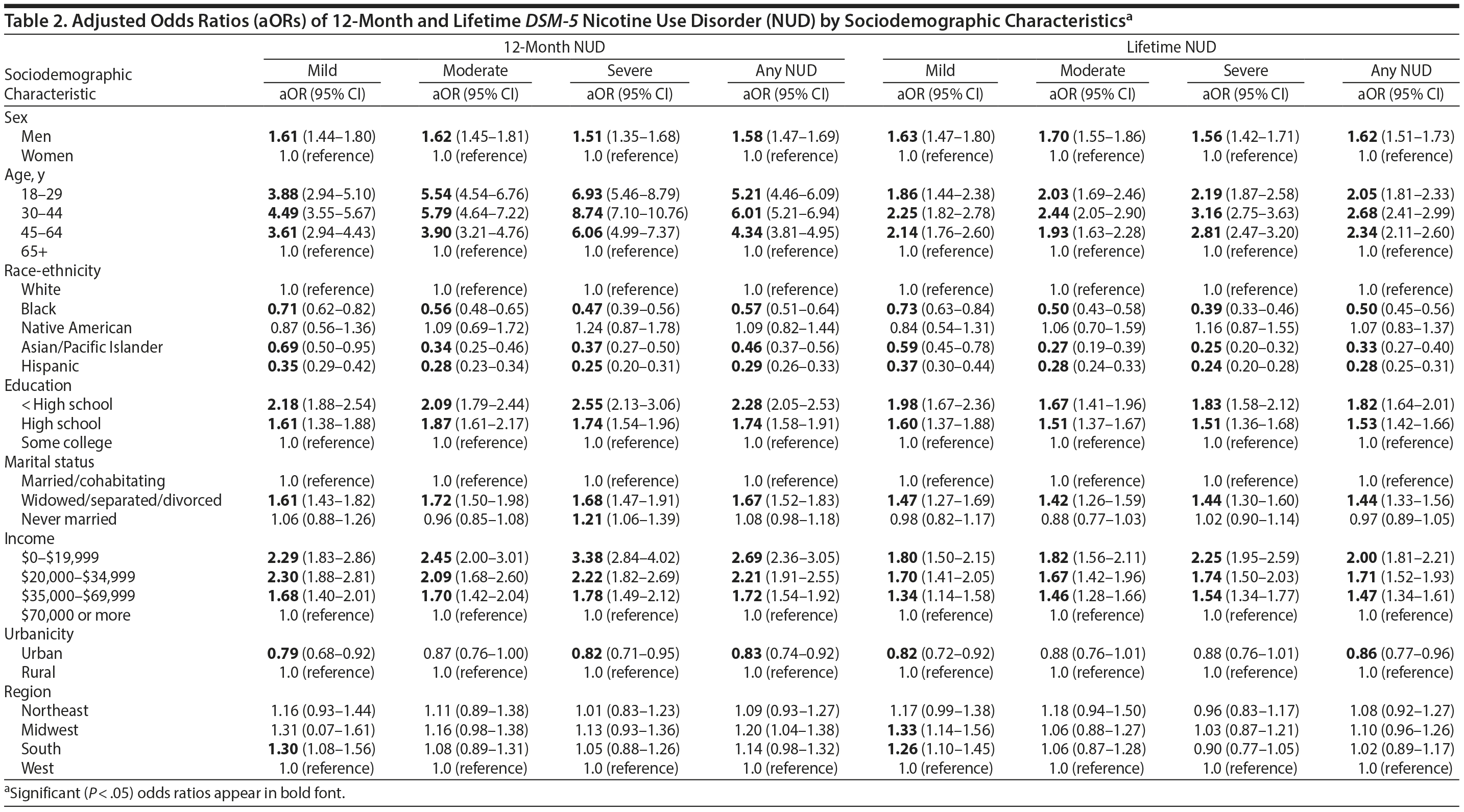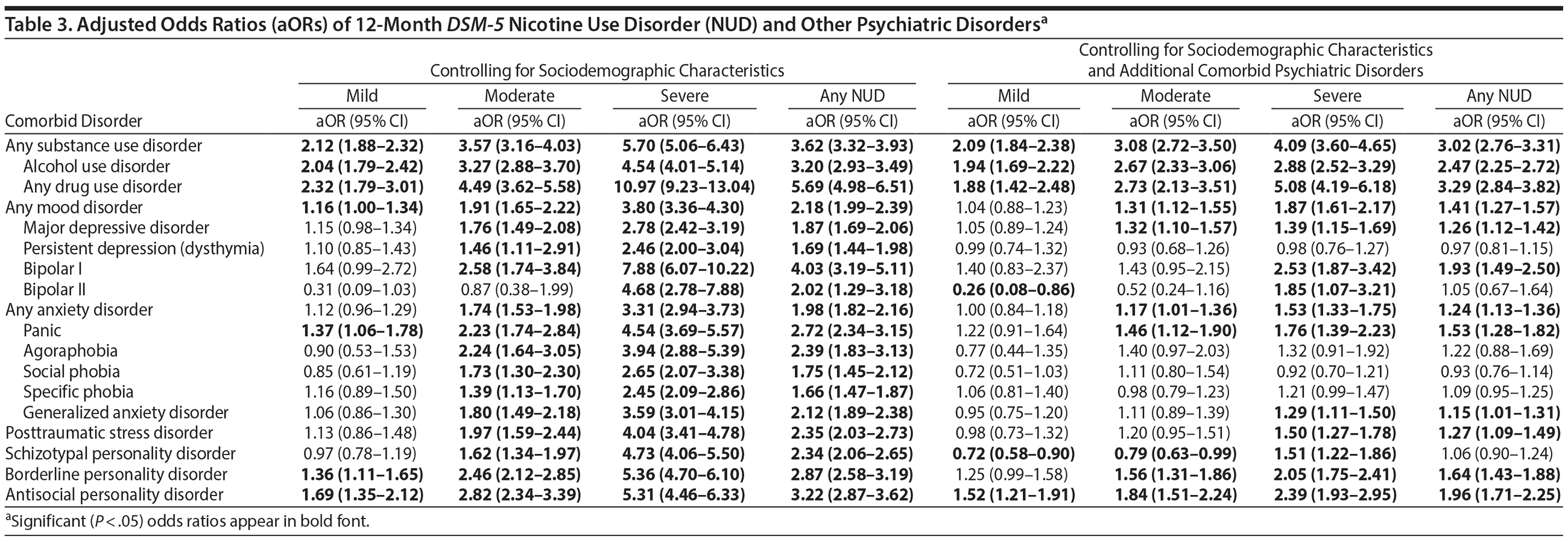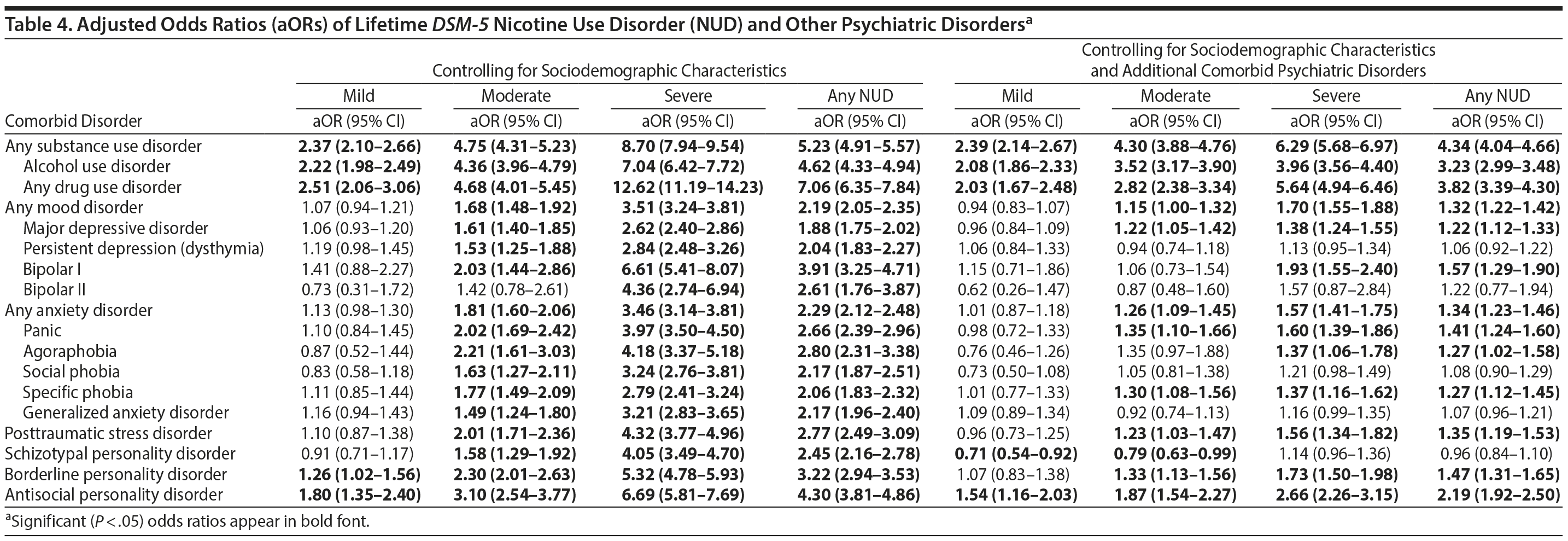Objective: To present nationally representative information on the prevalence, correlates, psychiatric comorbidity, and treatment of DSM-5 nicotine use disorder (NUD) and the public health burden of US cigarette consumption among adults with NUD and other psychiatric disorders.
Methods: Using data from the 2012-2013 National Epidemiologic Survey on Alcohol and Related Conditions-III (N = 36,309), we conducted weighted cross-tabulations and multivariate logistic regression analyses to estimate prevalences and examine comorbidity of NUD.
Results: Prevalences of 12-month and lifetime DSM-5 NUD were 20.0% and 27.9%, respectively. Nicotine use disorder was more frequent among men, non-Hispanic whites, younger individuals, the previously married, those with less education and lower incomes, and those residing in rural areas. Adjusting for sociodemographic characteristics and additional psychiatric comorbidity, 12-month NUD and lifetime NUD were significantly associated with other substance use and antisocial personality disorders (odds ratios [ORs] = 1.5-5.1, 12-month; 1.5-5.6, lifetime). Twelve-month severe NUD was generally associated with major depressive, bipolar I, bipolar II, panic, generalized anxiety, posttraumatic stress, and schizotypal, borderline, and antisocial personality disorders (ORs = 1.3-2.5). Individuals with current NUD and at least 1 psychiatric disorder comprised 11.1% of US adults but smoked 53.6% of total cigarettes consumed. Treatment was utilized by 20.3% of respondents with 12-month and 18.8% with lifetime NUD.
Conclusions: Findings underscore the need to address nicotine use in clinical settings. Recognition of psychiatrically vulnerable subpopulations may inform etiologic research, prevention, and treatment of NUD.


The Epidemiology of DSM-5 Nicotine Use Disorder:
Results From the National Epidemiologic Survey on Alcohol and Related Conditions-III


ABSTRACT
Objective: To present nationally representative information on the prevalence, correlates, psychiatric comorbidity, and treatment of DSM-5 nicotine use disorder (NUD) and the public health burden of US cigarette consumption among adults with NUD and other psychiatric disorders.
Methods: Using data from the 2012-2013 National Epidemiologic Survey on Alcohol and Related Conditions-III (N = 36,309), we conducted weighted cross-tabulations and multivariate logistic regression analyses to estimate prevalences and examine comorbidity of NUD.
Results: Prevalences of 12-month and lifetime DSM-5 NUD were 20.0% and 27.9%, respectively. Nicotine use disorder was more frequent among men, non-Hispanic whites, younger individuals, the previously married, those with less education and lower incomes, and those residing in rural areas. Adjusting for sociodemographic characteristics and additional psychiatric comorbidity, 12-month NUD and lifetime NUD were significantly associated with other substance use and antisocial personality disorders (odds ratios [ORs] = 1.5-5.1, 12-month; 1.5-5.6, lifetime). Twelve-month severe NUD was generally associated with major depressive, bipolar I, bipolar II, panic, generalized anxiety, posttraumatic stress, and schizotypal, borderline, and antisocial personality disorders (ORs = 1.3-2.5). Individuals with current NUD and at least 1 psychiatric disorder comprised 11.1% of US adults but smoked 53.6% of total cigarettes consumed. Treatment was utilized by 20.3% of respondents with 12-month and 18.8% with lifetime NUD.
Conclusions: Findings underscore the need to address nicotine use in clinical settings. Recognition of psychiatrically vulnerable subpopulations may inform etiologic research, prevention, and treatment of NUD.
J Clin Psychiatry 2016;77(10):1404-1412
dx.doi.org/10.4088/JCP.15m10114
© Copyright 2016 Physicians Postgraduate Press, Inc.
aLaboratory of Epidemiology and Biometry, Division of Intramural Clinical and Biological Research, National Institute on Alcohol Abuse and Alcoholism, National Institutes of Health
*Corresponding author: S. Patricia Chou, PhD, Laboratory of Epidemiology and Biometry, Division of Intramural Clinical and Biological Research, National Institute on Alcohol Abuse and Alcoholism, National Institutes of Health, 5635 Fishers Ln, Room 3071, Bethesda, MD 20892 ([email protected]).
Tobacco use is the largest and most preventable cause of mortality and morbidity worldwide.1-5 Globally, tobacco use has been linked to 6 million deaths each year and is projected to kill 8 million people annually by 2030.1-3 This growing epidemic, especially in the developing world, has prompted urgent calls for action by the World Health Organization.1-3 In the United States, half a million deaths annually are caused by tobacco, including those from cardiovascular and respiratory diseases, cancer, gastrointestinal ulcers, and diabetes.6-9 Tobacco use adds $130 billion yearly to health care costs, plus indirect costs of $150 billion due to lost productivity.5,6,10,11
High rates of tobacco use have been observed among psychiatric patients.12-15 Recent national surveys also found higher rates of tobacco use among adults with psychiatric disorders or serious psychological distress compared to those without these disorders.10,16,17 However, few studies have examined the prevalence and psychiatric comorbidity of rigorously diagnosed Diagnostic and Statistical Manual of Mental Disorders (DSM)-defined nicotine dependence among representative samples of the US general population. In the 2001-2002 National Epidemiologic Survey on Alcohol and Related Conditions (NESARC), 12-month and lifetime DSM-IV nicotine dependence prevalences were 12.8%18 and 17.7% (S.P.C., unpublished data, 2015), respectively. Elevated odds of comorbid mood, anxiety, other substance use, and personality disorders were observed among individuals with 12-month nicotine dependence.18,19 Twelve-month and lifetime rates of DSM-IV nicotine dependence in the National Comorbidity Survey Replication were 4.0% and 8.3%, respectively20; past-month prevalence of nicotine dependence estimated in the National Survey on Drug Use and Health among adults 18 years and older in 2012 was 13.6%.21
Previous national estimates of nicotine dependence were all based on DSM-IV criteria. However, the DSM-522 made major changes to the definition of nicotine dependence. In the DSM-5, the new definition of nicotine use disorder (NUD) was aligned with other substance use disorders through the addition of craving, inclusion of DSM-IV abuse criteria other than legal problems, establishment of a diagnostic threshold of ≥ 2 criteria, and creation of a severity metric that is based on criteria counts.23 Because of the seriousness of NUD, the lack of current epidemiologic data from a single, reliable uniform source represents a gap in critical knowledge for prevention and intervention. We, therefore, present national data on the prevalence, correlates, comorbidity, and treatment of DSM-5 NUD from the 2012-2013 NESARC-III.24 We also assessed DSM-IV criteria for nicotine dependence to examine changes in prevalences since 2001-2002. As is well known, the majority of nicotine consumption in the United States is in the form of cigarettes, and thus, the public health burden of nicotine use occurs almost entirely through cigarette smoking.18 To gain an understanding of the contribution of NUD and psychiatric disorders to this public health burden, we determined the percentage of all cigarettes in the United States that were consumed by individuals with NUD and psychiatric disorders.
METHODS
Sample
The target population of the 2012-2013 NESARC-III comprised the civilian, noninstitutionalized US population, 18 years and older, of households and selected group quarters.24 Respondents were selected through multistage probability sampling. Primary sampling units were counties or groups of contiguous counties, secondary sampling units comprised groups of Census-defined blocks, and tertiary sampling units were households within sampled secondary sampling units, within which eligible adult respondents were selected. Hispanic, black, and Asian individuals were assigned higher selection probabilities than nonminority household members. In households with 4 or more eligible minority individuals (n = 1,661), 2 respondents were selected. The sample size was 36,309, reflecting a household response rate of 72%, a person-level response rate of 84%, and an overall response rate of 60.1%, comparable to other current US national surveys.25,26


- The prevalence of DSM-5 nicotine use disorder in the United States is 20.0%.
- Nicotine use disorder was highly comorbid with other psychiatric disorders and largely goes untreated.
- Individuals with nicotine use disorder and psychiatric comorbidity bear the greater public health burden of US cigarette consumption, warranting greater prevention and intervention efforts.
- Integration of services for nicotine use disorder into primary care, mental health, and substance abuse treatment settings is warranted.
Data were adjusted for nonresponse, then weighted to represent the US civilian population based on the 2012 American Community Survey.27 Weighting adjustments compensated adequately for nonresponse.24 Respondents did not differ from the total eligible sample, including nonrespondents, in percent Hispanic, black, or Asian; population density; vacancy rate; proportion of population in group quarters; or proportion of renters at the segment level. There were no differences between respondents and the total eligible sample in Hispanic ethnicity. Respondents included slightly higher percentages of men (48.1% vs 46.2%) and individuals aged 60-69 years (13.7% vs 12.6%) and smaller percentages of individuals aged 40-49 years (18.1% vs 18.3%) and 30-39 years (16.7% vs 17.4%) than the eligible sample.
Interviewer field methods, detailed elsewhere,24 involved initial structured home study, in-person training, ongoing supervision, and random respondent callbacks to verify data. Respondents gave informed consent and received $90.00 for survey participation. Protocols were approved by the institutional review boards of the US National Institutes of Health and Westat, Inc.
Assessments
The diagnostic interview was the National Institute on Alcohol Abuse and Alcoholism (NIAAA) Alcohol Use Disorder and Associated Disabilities Interview Schedule-5 (AUDADIS-5),28,29 designed to measure DSM-5 NUD, alcohol use disorder, specific drug use disorders, and selected mood, anxiety, trauma-related, eating, and personality disorder diagnoses. The AUDADIS-5 also assessed DSM-IV nicotine dependence criteria to enable comparisons of current NESARC-III findings with those from the previous 2001-2002 NESARC survey.
Nicotine Use Disorders
Consistent with DSM-5, lifetime NUD diagnoses required ≥ 2 of the 11 criteria in the 12 months before interview or previously. Prior-to-the-last-12-months diagnoses required clustering of ≥ 2 criteria in a single year. DSM-5 NUD diagnoses were classified as mild (2-3 criteria), moderate (4-5 criteria), or severe (≥ 6 criteria). DSM-IV lifetime nicotine dependence required ≥ 3 criteria in the past year or previously. Prior-to-the-past-year DSM-IV diagnoses also required clustering of criteria within a single year. Concordances between 12-month and lifetime DSM-IV nicotine dependence and DSM-5 NUD were high (κ = 0.79, 0.84, respectively; R.B.G., unpublished data, 2015). In the present study, NUD and nicotine dependence were assessed for any tobacco product including cigarettes, cigars, pipes, chewing tobacco, snuff, and e-cigarettes/e-liquid.
Reliability of DSM-5 NUD diagnoses (κ = 0.50-0.87) and associated dimensional scales (intraclass correlation coefficient [ICC] = 0.83-0.84) was fair to excellent in a large general population sample.29 Procedural validity was assessed by clinical reappraisal using the semistructured, clinician-administered Psychiatric Research Interview for Substance and Mental Disorders, DSM-5 version (PRISM-5),30 in a large general population sample. Concordances between AUDADIS-5 and PRISM-5 NUD diagnoses were fair to good (κ = 0.54-0.68), whereas concordances between the criteria scales were excellent (ICC = 0.80-0.84).31 Test-retest reliability of 12-month and lifetime DSM-IV nicotine dependence diagnoses and symptom scales, and convergent validity of diagnoses, were fair to excellent in the general population.18
Other Psychiatric Disorders
Current and lifetime DSM-5 alcohol use disorder and drug use disorder diagnoses were derived similarly to those for NUD. Specific drug use disorders included sedative/tranquilizer, cannabis, amphetamine, cocaine, non-heroin opioid, heroin, hallucinogen, and solvent/inhalant use disorders. These diagnoses were aggregated to yield a diagnosis of any drug use disorder. Test-retest reliabilities were good for alcohol use disorder (κ = 0.60-0.62) and fair for drug use disorder (κ = 0.40-0.54) diagnoses and higher for their criteria scales (ICC = 0.83-0.85 for alcohol use disorder, 0.45-0.84 for drug use disorder).29 Concordances between AUDADIS-5 and PRISM-5 diagnoses and dimensional scales for alcohol use disorder and drug use disorder were fair to good (κ = 0.35-0.62; ICCs > 0.68, except for past-year sedatives and stimulants [0.38, 0.44, respectively]).31
DSM-5 mood disorders included major depressive disorder, dysthymia, and bipolar I and bipolar II disorders. Anxiety disorders included DSM-5 panic, agoraphobia, social and specific phobias, and generalized anxiety disorder. Consistent with DSM-5, primary mood and anxiety diagnoses excluded substance- and medical illness-induced disorders. In addition to mood and anxiety disorders, posttraumatic stress disorder, anorexia nervosa, bulimia nervosa, binge-eating disorder, and schizotypal, borderline, and antisocial personality disorders were assessed. Details on the psychometric properties of these diagnoses are reported elsewhere.29,32
Current Cigarette Smokers and Number of Cigarettes Smoked
Among lifetime smokers of ≥ 100 cigarettes, current use consisted of any smoking during the year before interview. Among current smokers, the number of cigarettes smoked in the past year was the product of answers to the questions: “On the days that you smoked in the past year, about how many cigarettes did you usually smoke?” and “About how often did you usually smoke in the past year?” (eg, daily, 5 to 6 days per week). Test-retest reliabilities of these measures were excellent (ICC = 0.74-0.84).33
Statistical Analysis
Weighted cross-tabulations estimated prevalences of NUD for the total sample and by sociodemographic characteristics. Multivariable logistic regression analyses estimated associations of NUD and sociodemographic variables controlling for all others. Logistic regressions of psychiatric comorbidity of NUD adjusted for (1) only sociodemographic characteristics and (2) sociodemographic characteristics and all other psychiatric and substance use disorders. Eating disorders were too rare to assess their comorbid associations with NUD but were included as covariates in comorbidity analyses of NUD with other disorders.
We multiplied the total number of cigarettes smoked in the past year by the weighted number of persons in the following 4 groups to arrive at the percentage of all cigarettes consumed in the past year in each group: (1) cigarette smokers with NUD and a comorbid psychiatric disorder, (2) cigarette smokers with NUD but without a comorbid psychiatric disorder, (3) cigarette smokers without NUD but with a psychiatric disorder, and (4) cigarette smokers without NUD or a psychiatric disorder. All analyses utilized SUDAAN, version 11.0 (Research Triangle Park, North Carolina),34 which accounts for the complex sample design of the NESARC-III.
RESULTS
Current and Lifetime Nicotine and Cigarette Use
Prevalences of 12-month (27.2%) and lifetime (45.8%) any nicotine use observed in the NESARC-III were similar to those reported in the 2001-2002 NESARC (28.4% and 46.9%; S.P.C., unpublished data, 2015). Similarly, prevalences of 12-month and lifetime cigarette use in the NESARC-III (23.5%, 12-month; 42.0%, lifetime) remained virtually identical to rates reported in the 2001-2002 NESARC (24.9%, 12-month; 43.7%, lifetime; S.P.C., unpublished data, 2015).
Prevalence and Sociodemographic Characteristics of DSM-5 Nicotine Use Disorder
As shown in Table 1, prevalences of 12-month and lifetime DSM-5 NUD were 20.0% and 27.9%, respectively. Prevalences of 12-month mild, moderate, and severe NUD were 6.6%, 6.5%, and 6.9%, respectively. Rates of 12-month and lifetime DSM-IV nicotine dependence in the NESARC-III were 14.0% and 22.0%, respectively, which were somewhat higher than those in the 2001-2002 NESARC (12.8% and 17.7%, respectively; S.P.C., unpublished data, 2015). Table 2 shows the adjusted odds ratios of DSM-5 NUD by sociodemographic characteristics. Odds of 12-month and lifetime DSM-5 NUD were consistently greater among men, among the 3 youngest age groups, among individuals who were widowed/separated/divorced, and among those with lower education and lower incomes across all severity levels. The odds of 12-month NUD were generally lower among individuals who resided in urban areas, a result that generalized to respondents with any lifetime NUD and lifetime mild NUD. Odds of 12-month and lifetime mild NUD were greater in the South relative to the West.
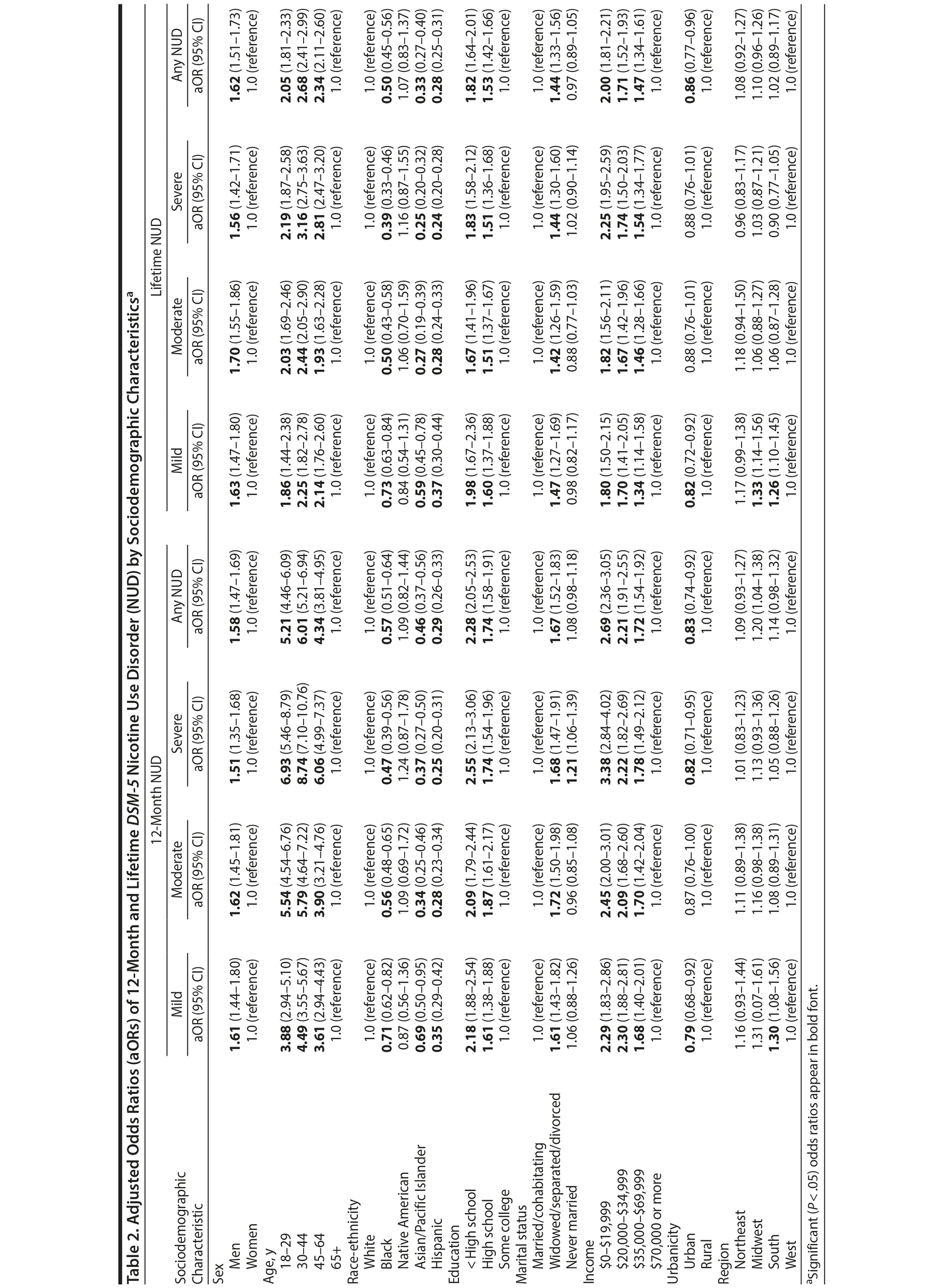

Comorbidity of Nicotine Use Disorder
Associations between 12-month and lifetime NUD and psychiatric disorders are shown in Tables 3 and 4, respectively. When only sociodemographic variables were controlled, 12-month and lifetime any NUD, moderate NUD, and severe NUD were associated with virtually all other psychiatric disorders assessed in the NESARC-III, while mild NUD was positively associated with other substance use disorders, panic disorder, and schizotypal and antisocial personality disorders.
After adjustment for sociodemographic characteristics and other psychiatric comorbidity, other substance use disorders and antisocial personality disorder were significantly (P < .05) and positively associated with 12-month NUD across severity levels. Further, major depressive disorder, panic disorder, and borderline personality disorder were positively associated with any, moderate, and severe NUD whereas bipolar I, generalized anxiety, and posttraumatic stress disorders were positively associated with any and severe NUD. Schizotypal personality disorder was negatively associated with mild and moderate NUD, but positively associated with severe NUD. Bipolar II disorder was negatively associated with mild, but positively associated with severe NUD (Table 3).
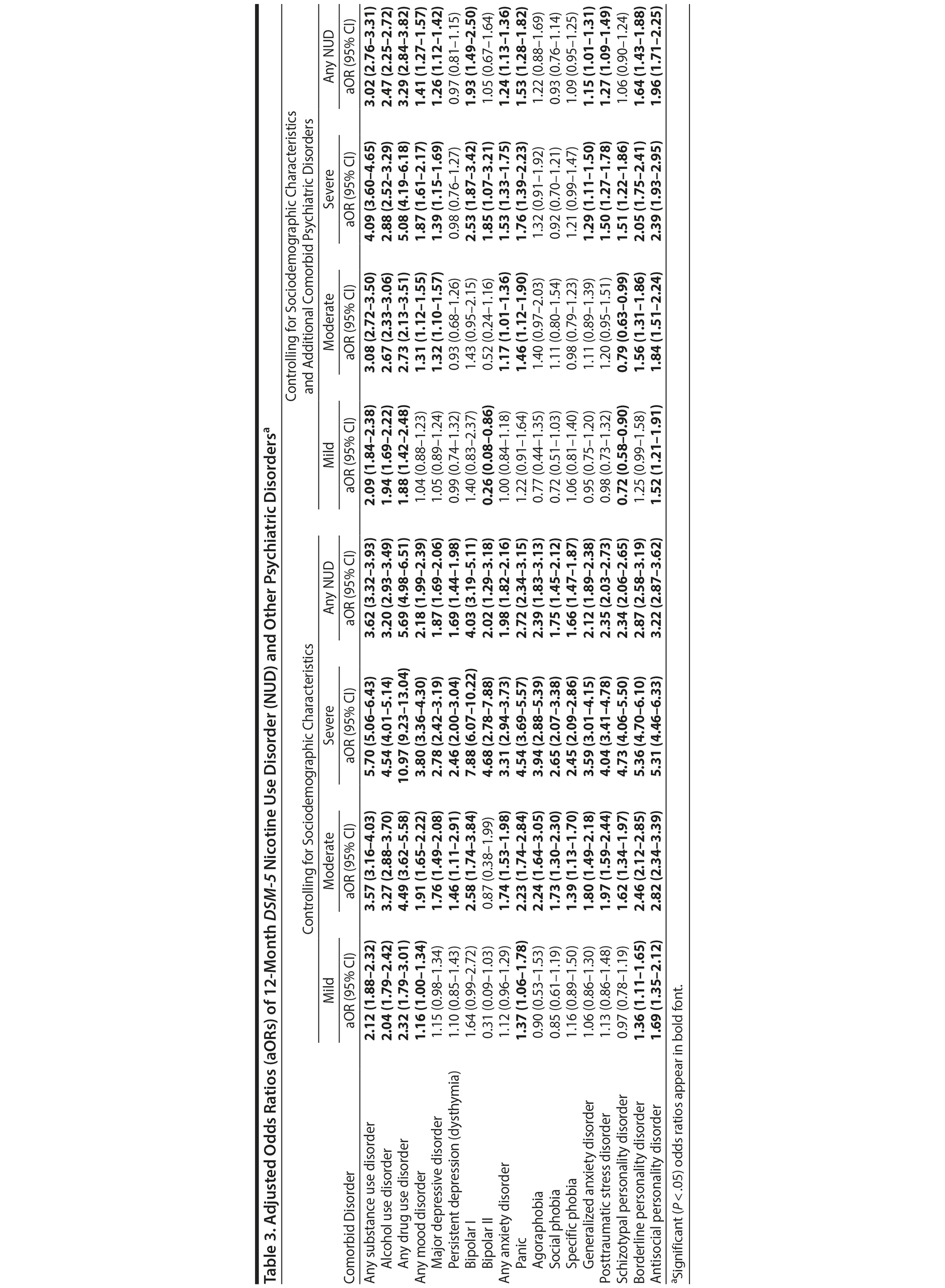

Lifetime comorbidity results generally mirrored those found among 12-month disorders. However, unlike 12-month comorbidity findings, agoraphobia was positively associated with any and severe NUD, specific phobia was associated with any moderate and severe NUD, and posttraumatic stress disorder was associated with moderate NUD. Schizotypal personality disorder and generalized anxiety disorder were no longer related to lifetime severe NUD (Table 4).
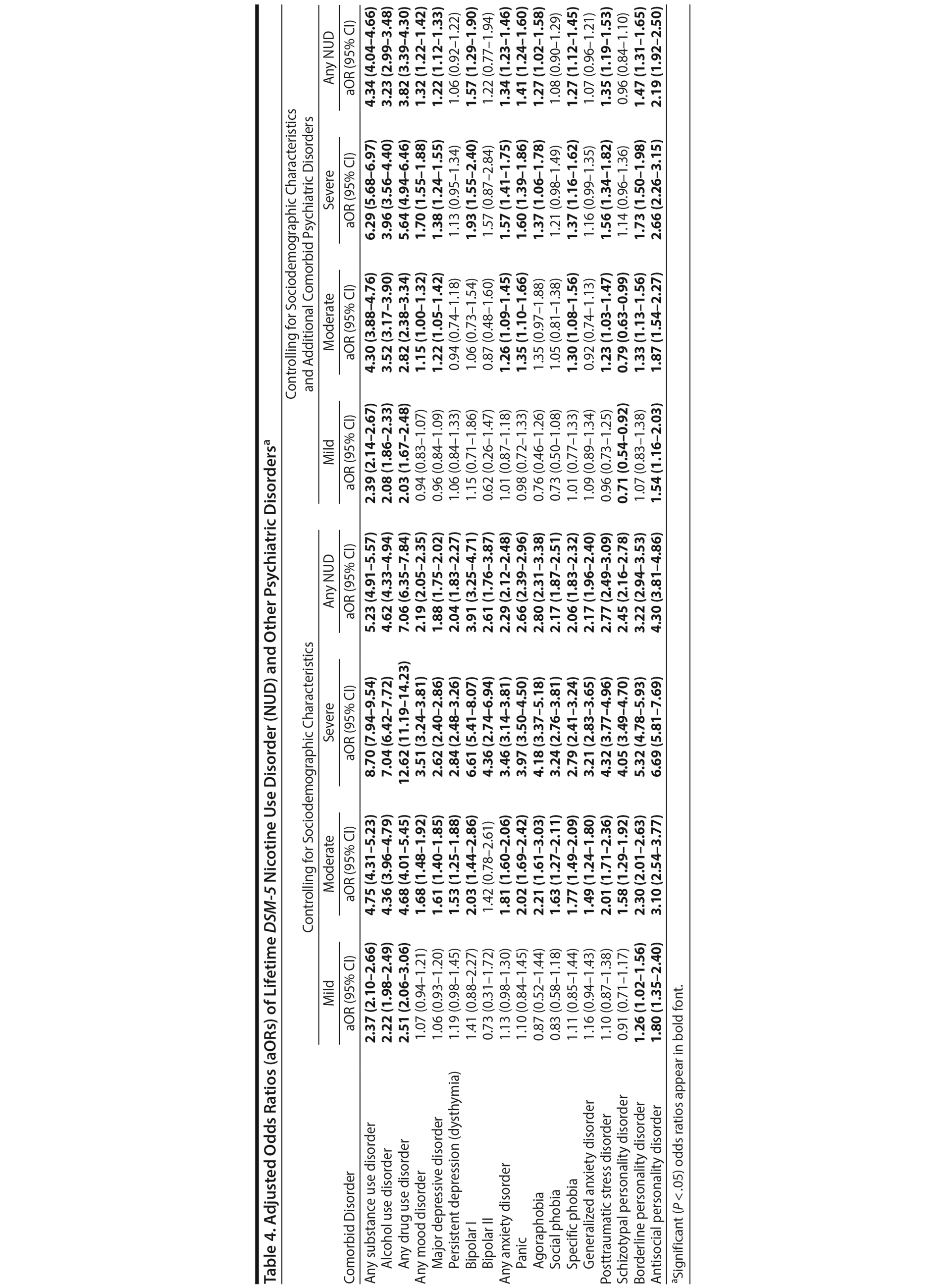

Burden of Current US Cigarette Consumption
Individuals with current NUD accounted for 20.0% of all US adults but consumed 89.6% of all cigarettes. Adults with a current psychiatric disorder (with and without NUD) comprised 36.4% of US adults but consumed 56.4% of all cigarettes. Those with current NUD and at least 1 current psychiatric disorder constituted only 11.1% of US adults but smoked 53.6% of total cigarettes consumed.
Individuals without any NUD psychiatric disorder comorbidity accounted for lower percentages of cigarettes smoked. Those with current NUD but no psychiatric disorder smoked 36.0% of all cigarettes; those with a current psychiatric disorder but no NUD smoked 2.7% of total cigarettes; and individuals with neither NUD nor a current psychiatric disorder smoked 7.7% of all cigarettes.
Treatment Utilization for Nicotine Use Disorder
As shown in Table 5, overall treatment rates were 20.3% and 18.8% for 12-month and lifetime NUD, respectively. Treatment was positively associated with NUD severity, ranging from 9.4% to 29.1% for current and 6.7%-27.8% for lifetime NUD.
Among specific treatments, prescribed medications (eg, varenicline, bupropion) and nicotine replacements were used most commonly. Support groups, Internet chat rooms, and acupuncture or meditation were among the least utilized modalities.
DISCUSSION
In the NESARC-III, 12-month (27.2%) and lifetime (45.8%) prevalences of nicotine use remained virtually unchanged since 2001-2002 (12-month, 28.4%; lifetime, 46.9%; S.P.C., unpublished data, 2015). A similar trend was found for 12-month (23.5% vs 24.9% [S.P.C., unpublished data, 2015]) and lifetime (42.0% vs 43.7% [S.P.C., unpublished data, 2015]) cigarette use.
Prevalences of 12-month and lifetime DSM-5 NUD in the NESARC-III were 20.0% and 27.9%, respectively, representing 47,147,599 and 65,599,467 American adults. Corresponding DSM-IV rates in the NESARC-III were 14.0% (12-month) and 22.0% (lifetime), which were somewhat higher than those observed in the 2001-2002 NESARC (12-month, 12.8%; lifetime, 17.7%; S.P.C., unpublished data, 2015). While DSM-IV is no longer the current nomenclature, increases in disorder absent increases in use may still warrant investigation into possible contributors, including posttraumatic stress disorder related to the September 11, 2001, attacks and the impacts of 2 long wars in Afghanistan and Iraq, as well as severe economic downturn.35-38
Consistent with findings for current nicotine use39 and other substance use disorders,40-42 rates of NUD were higher among men. Nicotine use disorder, particularly 12-month moderate and severe disorders, was inversely related to age. Future prospective research is needed to identify mechanisms underlying these relationships. Nevertheless, together with findings on early onset of nicotine use,43 these results reinforce the need for continued and expanded prevention targeting preadolescents and adolescents and intervention activities that are appropriate across the lifespan.
Findings on race or ethnicity identify lower risks among blacks, Asians/Pacific Islanders, and Hispanics, than non-Hispanic whites. Nevertheless, lower rates among these minority groups do not negate the importance of prevention of both nicotine use and NUD, or of intervening appropriately when these occur. Future research should characterize biological and sociocultural risk factors among whites and protective factors among blacks, Asians/Pacific Islanders, and Hispanics. This information will further understanding of NUD etiology and inform appropriate prevention and intervention programs.
After adjustment for sociodemographics and additional comorbidity, we observed significant, positive associations of 12-month and lifetime DSM-5 NUD with other DSM-5 substance use, major depressive, bipolar I, panic, generalized anxiety, posttraumatic stress, and borderline and antisocial personality disorders. Generalized anxiety disorder was associated with severe 12-month NUD whereas agoraphobia and specific phobia were associated only with severe lifetime NUD. Twelve-month mild NUD was also negatively associated with bipolar II disorder, and 12-month mild and moderate NUD and lifetime moderate NUD were negatively associated with schizotypal personality disorder. Stronger associations with adjustment only for sociodemographic characteristics suggest that factors common to NUD and comorbid disorders partly explain the associations. However, the persistence of these relationships after adjustment for additional comorbidity suggests important, unique underlying neurobiological or psychosocial factors. The present findings, along with genetic studies,44 call for further study of correlates, predictors, and mechanisms of NUD comorbidity, including differing directions of association by NUD severity with bipolar II and schizotypal personality disorder.
The burden of US cigarette consumption among psychiatrically comorbid individuals with NUD appears even greater than that among individuals with nicotine dependence in our previous study.18 Individuals with NUD smoked a greater percentage of cigarettes in the present study compared to those without NUD (89.6% vs 57.5%), especially those with comorbid psychopathology (53.6% vs 34.6%), relative to their respective representations in the US general population (20.0% and 11.1% vs 12.8% and 7.1%).18 Increasing evidence demonstrates that tobacco industry marketing segments smokers by sociodemographic and psychological vulnerability factors. Reflecting both sociodemographic disadvantage and psychiatric comorbidity, smokers with NUD bear disproportionate economic and public health burdens and have limited access to treatment, longer duration of smoking, and higher rates of failed cessation attempts.44-47 The present results echo the call by Apollonio and Malone45 for countermeasures to curb smoking among these vulnerable individuals, and by others48 to further identify this segment of the population as an important disparity group for tobacco control programs.
Rates of help seeking were low for both 12-month (20.3%) and lifetime (18.8%) DSM-5 NUD. The most frequently utilized treatments (prescribed medications and nicotine replacement), however, included modalities with strongest empirical support.49-51 With some modifications, standard pharmacologic and psychosocial treatments can be used effectively and safely in smokers with comorbid psychopathology, including substance use disorders.51 Nevertheless, better integration of NUD services into health care settings including mental health and other substance use disorder treatment is clearly needed.51,52 Research examining perceived needs for and barriers to NUD treatment among smokers with and without psychiatric comorbidity is also warranted.
Study limitations include its cross-sectional design, which precludes causal interpretation of results. Since the NESARC-III sample excluded active military personnel and most homeless and institutionalized individuals, estimates presented here may underestimate the true prevalence of NUD. Respondents’ self-reports of socially disvalued behaviors, including nicotine use and NUD symptoms, may have also led to underestimation of the true prevalence of these conditions.53 The lack of biochemical verification of smoking status is also a study limitation.
Despite these limitations, the present study is the first to report nationally representative US data on the epidemiology of DSM-5 NUD among US adults. It extends previous examinations of psychiatric comorbidity of NUD, including a lifetime perspective as well as investigation of unique associations independent of other disorders. Our findings of substantial comorbidity of NUD and low rates of treatment underscore the importance of identification and intervention with every tobacco-using patient at every primary care or specialty mental health visit.54,55 Of note, tobacco users’ satisfaction with medical care is positively associated with physician attention to smoking cessation.56 Beyond these considerations, recognition of psychiatrically vulnerable population subgroups may inform future research on genetic and environmental determinants of NUD and its psychiatric comorbidities, as well as improved prevention and treatment for these burdensome conditions.
Submitted: May 16, 2015; accepted October 7, 2015.
Online first: April 26, 2016.
Drug names: bupropion (Wellbutrin and others), varenicline (Chantix).
Potential conflicts of interest: No conflicts of interest were declared by any author.
Funding/support: The National Epidemiologic Survey on Alcohol and Related Conditions-III (NESARC-III) is funded by the National Institute on Alcohol Abuse and Alcoholism (NIAAA) with supplemental support from the National Institute on Drug Abuse, National Institutes of Health, Bethesda, Maryland.
Role of the sponsor: Sponsors and funders of the NESARC-III had no role in the design and conduct of the study; collection, management, analysis, and interpretation of the data; and preparation, review, and approval of the manuscript.
Disclaimer: The views and opinions expressed in this report are those of the authors and should not be construed to represent the views of any of the sponsoring organizations or agencies or the US government.
Database information: Data access information for the NESARC-III is available at http://www.niaaa.nih.gov/research/nesarc-iii/nesarc-iii-data-access.
REFERENCES
1. World Health Organization. Tobacco Fact Sheet No. 339. Geneva, Switzerland: The Organization; 2014.
2. World Health Organization. Report on the Global Tobacco Epidemic. Geneva, Switzerland: The Organization; 2013.
3. World Health Organization. Report on the Global Tobacco Epidemic. Geneva, Switzerland: The Organization; 2011.
4. Current cigarette smoking among adults in the United States. Centers for Disease Control and Prevention Web site. http://www.cdc.gov/tobacco/data_statistics/fact_sheets/adult_data/cig_smoking/. Updated December 8, 2015. Accessed March 15, 2016.
5. Jamal A, Agaku IT, O’ Connor E, et al. Current cigarette smoking among adults—United States, 2005-2013. MMWR Morb Mortal Wkly Rep. 2014;63(47):1108-1112. PubMed
6. The Health Consequences of Smoking—50 Years of Progress: A Report of the Surgeon General, 2014. US Department of Health and Human Services Web site. http://www.surgeongeneral.gov/library/reports/50-years-of-progress/index.html. Updated 2014. Accessed March 15, 2016.
7. Chu KM, Cho CH, Shin VY. Nicotine and gastrointestinal disorders: its role in ulceration and cancer development. Curr Pharm Des. 2013;19(1):5-10. PubMed
8. Forouhi NG, Wareham NJ. Epidemiology of diabetes. Medicine (Abingdon). 2014;42(12):698-702. PubMed
9. Li LF, Chan RL, Lu L, et al. Cigarette smoking and gastrointestinal diseases: the causal relationship and underlying molecular mechanisms (review). Int J Mol Med. 2014;34(2):372-380. PubMed
10. Centers for Disease Control and Prevention (CDC). Cigarette smoking among adults—United States, 2007. MMWR Morb Mortal Wkly Rep. 2008;57(45):1221-1226. PubMed
11. Centers for Disease Control and Prevention (CDC). Smoking-attributable mortality, years of potential life lost, and productivity losses—United States, 2000-2004. MMWR Morb Mortal Wkly Rep. 2008;57(45):1226-1228. PubMed
12. Kalman D, Morissette SB, George TP. Co-morbidity of smoking in patients with psychiatric and substance use disorders. Am J Addict. 2005;14(2):106-123. PubMed doi:10.1080/10550490590924728
13. Moeller-Saxone K. Cigarette smoking and interest in quitting among consumers at a Psychiatric Disability Rehabilitation and Support Service in Victoria. Aust N Z J Public Health. 2008;32(5):479-481. PubMed doi:10.1111/j.1753-6405.2008.00283.x
14. Lucksted A, McGuire C, Postrado L, et al. Specifying cigarette smoking and quitting among people with serious mental illness. Am J Addict. 2004;13(2):128-138. PubMed doi:10.1080/10550490490436000
15. Waxmonsky JA, Thomas MR, Miklowitz DJ, et al. Prevalence and correlates of tobacco use in bipolar disorder: data from the first 2000 participants in the Systematic Treatment Enhancement Program. Gen Hosp Psychiatry. 2005;27(5):321-328. PubMed doi:10.1016/j.genhosppsych.2005.05.003
16. Glasheen C, Hedden SL, Forman-Hoffman VL, et al. Cigarette smoking behaviors among adults with serious mental illness in a nationally representative sample. Ann Epidemiol. 2014;24(10):776-780. PubMed doi:10.1016/j.annepidem.2014.07.009
17. McClave AK, McKnight-Eily LR, Davis SP, et al. Smoking characteristics of adults with selected lifetime mental illnesses: results from the 2007 National Health Interview Survey. Am J Public Health. 2010;100(12):2464-2472. PubMed doi:10.2105/AJPH.2009.188136
18. Grant BF, Hasin DS, Chou SP, et al. Nicotine dependence and psychiatric disorders in the United States: results from the National Epidemiologic Survey on Alcohol and Related Conditions. Arch Gen Psychiatry. 2004;61(11):1107-1115. PubMed doi:10.1001/archpsyc.61.11.1107
19. Goodwin RD, Zvolensky MJ, Keyes KM, et al. Mental disorders and cigarette use among adults in the United States. Am J Addict. 2012;21(5):416-423. PubMed doi:10.1111/j.1521-0391.2012.00263.x
20. Cougle JR, Zvolensky MJ, Fitch KE, et al. The role of comorbidity in explaining the associations between anxiety disorders and smoking. Nicotine Tob Res. 2010;12(4):355-364. PubMed doi:10.1093/ntr/ntq006
21. Results from the 2012 National Survey on Drug Use and Health: Detailed Tables, Table 6.34B. Substance Abuse and Mental Health Services Administration Web site. http://www.samhsa.gov/data/sites/default/files/NSDUH-DetTabs2012/NSDUH-DetTabs2012/PDFW/NSDUH-DetTabsSect6peTabs33to37-2012.pdf. Accessed March 15, 2016.
22. American Psychiatric Association. Diagnostic and Statistical Manual for Mental Disorders. Fifth Edition. Washington, DC: American Psychiatric Association; 2013.
23. Hasin DS, O’ Brien CP, Auriacombe M, et al. DSM-5 criteria for substance use disorders: recommendations and rationale. Am J Psychiatry. 2013;170(8):834-851. PubMed doi:10.1176/appi.ajp.2013.12060782
24. Grant BF, Amsbary M, Chu A, et al. Source and Accuracy Statement: National Epidemiologic Survey on Alcohol and Related Conditions-III (NESARC-III). Rockville, MD: National Institute on Alcohol Abuse and Alcoholism; 2014.
25. Results from the 2012 National Survey on Drug Use and Health: Summary of National Findings, Appendix B: statistical methods and measurement. Substance Abuse and Mental Health Services Administration Web site. http://www.samhsa.gov/data/nsduh/2012summnatfinddettables/
nationalfindings/nsduhresults2012.htm#AppB. Updated September 2013. Accessed March 15, 2016.
26. Blackwell DL, Lucas JW, Clarke TC. Summary health statistics for US adults: National Health Interview Survey, 2012. Vital Health Stat 10. 2014;(260):1-161. PubMed
27. Bureau of the Census. American Community Survey, 2012. Suitland, MD: The Bureau; 2013.
28. Grant BF, Goldstein RB, Chou SP, et al. The Alcohol Use Disorder and Associated Disabilities Interview Schedule-Diagnostic and Statistical Manual of Mental Disorders, Fifth Edition Version (AUDADIS-5). Rockville, MD: National Institute on Alcohol Abuse and Alcoholism; 2011.
29. Grant BF, Goldstein RB, Smith SM, et al. The Alcohol Use Disorder and Associated Disabilities Interview Schedule-5 (AUDADIS-5): reliability of substance use and psychiatric disorder modules in a general population sample. Drug Alcohol Depend. 2015;148:27-33. PubMed doi:10.1016/j.drugalcdep.2014.11.026
30. Hasin DS, Aivadyan C, Greenstein E, et al. Psychiatric Research Interview for Substance Use and Mental Disorders, Diagnostic and Statistical Manual of Mental Disorders, Fifth Edition (PRISM-5) Version. New York, NY: Columbia University, Department of Psychiatry; 2011.
31. Hasin DS, Greenstein E, Aivadyan C, et al. The Alcohol Use Disorder and Associated Disabilities Interview Schedule-5 (AUDADIS-5): procedural validity of substance use disorders modules through clinical re-appraisal in a general population sample. Drug Alcohol Depend. 2015;148:40-46. PubMed doi:10.1016/j.drugalcdep.2014.12.011
32. Hasin DS, Shmulewitz D, Stohl M, et al. Procedural validity of the AUDADIS-5 depression, anxiety and post-traumatic stress disorder modules: substance abusers and others in the general population. Drug Alcohol Depend. 2015;152(1):246-256. PubMed doi:10.1016/j.drugalcdep.2015.03.027
33. Grant BF, Dawson DA, Stinson FS, et al. The Alcohol Use Disorder and Associated Disabilities Interview Schedule-IV (AUDADIS-IV): reliability of alcohol consumption, tobacco use, family history of depression and psychiatric diagnostic modules in a general population sample. Drug Alcohol Depend. 2003;71(1):7-16. PubMed doi:10.1016/S0376-8716(03)00070-X
34. SUDAAN Language Manual, Release 11.0 [computer program]. Research Triangle Park, NC: Research Triangle Institute; 2012.
35. Cooper B. Economic recession and mental health: an overview. Neuropsychiatr. 2011;25(3):113-117. PubMed
36. Fu SS, McFall M, Saxon AJ, et al. Post-traumatic stress disorder and smoking: a systematic review. Nicotine Tob Res. 2007;9(11):1071-1084. PubMed doi:10.1080/14622200701488418
37. Galea S, Resnick H, Ahern J, et al. Posttraumatic stress disorder in Manhattan, New York City, after the September 11th terrorist attacks. J Urban Health. 2002;79(3):340-353. PubMed doi:10.1093/jurban/79.3.340
38. Compton WM, Gfroerer J, Conway KP, et al. Unemployment and substance outcomes in the United States 2002-2010. Drug Alcohol Depend. 2014;142(1):350-353. PubMed doi:10.1016/j.drugalcdep.2014.06.012
39. King BA, Dube SR, Tynan MA. Current tobacco use among adults in the United States: findings from the National Adult Tobacco Survey. Am J Public Health. 2012;102(11):e93-e100. PubMed doi:10.2105/AJPH.2012.301002
40. Grant BF, Goldstein RB, Saha TD, et al. Epidemiology of DSM-5 alcohol use disorder: results from the National Epidemiologic Survey on Alcohol and Related Conditions III. JAMA Psychiatry. 2015;72(8):757-766. PubMed doi:10.1001/jamapsychiatry.2015.0584
41. Hasin DS, Stinson FS, Ogburn E, et al. Prevalence, correlates, disability, and comorbidity of DSM-IV alcohol abuse and dependence in the United States: results from the National Epidemiologic Survey on Alcohol and Related Conditions. Arch Gen Psychiatry. 2007;64(7):830-842. PubMed doi:10.1001/archpsyc.64.7.830
42. Compton WM, Thomas YF, Stinson FS, et al. Prevalence, correlates, disability, and comorbidity of DSM-IV drug abuse and dependence in the United States: results from the National Epidemiologic Survey on Alcohol and Related Conditions. Arch Gen Psychiatry. 2007;64(5):566-576. PubMed doi:10.1001/archpsyc.64.5.566
43. Preventing tobacco use among youth and young adults: a report of the Surgeon General, 2012. US Department of Health and Human Services Web site. http://www.surgeongeneral.gov/library/reports/preventing-youth-tobacco-use/. Accessed March 15, 2016.
44. Agrawal A, Lynskey MT. Are there genetic influences on addiction: evidence from family, adoption and twin studies. Addiction. 2008;103(7):1069-1081. PubMed doi:10.1111/j.1360-0443.2008.02213.x
45. Apollonio DE, Malone RE. Marketing to the marginalised: tobacco industry targeting of the homeless and mentally ill. Tob Control. 2005;14(6):409-415. PubMed doi:10.1136/tc.2005.011890
46. Kahler CW, Daughters SB, Leventhal AM, et al. Personality, psychiatric disorders, and smoking in middle-aged adults. Nicotine Tob Res. 2009;11(7):833-841. PubMed doi:10.1093/ntr/ntp073
47. Cook BL, Wayne GF, Keithly L, et al. One size does not fit all: how the tobacco industry has altered cigarette design to target consumer groups with specific psychological and psychosocial needs. Addiction. 2003;98(11):1547-1561. PubMed doi:10.1046/j.1360-0443.2003.00563.x
48. Williams JM, Steinberg ML, Griffiths KG, et al. Smokers with behavioral health comorbidity should be designated a tobacco use disparity group. Am J Public Health. 2013;103(9):1549-1555. PubMed doi:10.2105/AJPH.2013.301232
49. Cox LS, Okuyemi K, Choi WS, et al. A review of tobacco use treatments in US ethnic minority populations. Am J Health Promot. 2011;25(5 suppl):S11-S30. PubMed doi:10.4278/ajhp.100610-LIT-177
50. Herman AI, Sofuoglu M. Comparison of available treatments for tobacco addiction. Curr Psychiatry Rep. 2010;12(5):433-440. PubMed doi:10.1007/s11920-010-0134-6
51. Mackowick KM, Lynch MJ, Weinberger AH, et al. Treatment of tobacco dependence in people with mental health and addictive disorders. Curr Psychiatry Rep. 2012;14(5):478-485. PubMed doi:10.1007/s11920-012-0299-2
52. Rigotti NA. Integrating comprehensive tobacco treatment into the evolving US health care system: it’s time to act: comment on “A randomized trial of Internet and telephone treatment for smoking cessation”. Arch Intern Med. 2011;171(1):53-55. PubMed doi:10.1001/archinternmed.2010.491
53. Tourangeau R, Yan T. Sensitive questions in surveys. Psychol Bull. 2007;133(5):859-883. PubMed doi:10.1037/0033-2909.133.5.859
54. Clair C, Rigotti NA, Porneala B, et al. Association of smoking cessation and weight change with cardiovascular disease among adults with and without diabetes. JAMA. 2013;309(10):1014-1021. PubMed doi:10.1001/jama.2013.1644
55. Cole HM, Fiore MC. The war against tobacco: 50 years and counting. JAMA. 2014;311(2):131-132. PubMed doi:10.1001/jama.2013.280767
56. Conroy MB, Majchrzak NE, Regan S, et al. The association between patient-reported receipt of tobacco intervention at a primary care visit and smokers’ satisfaction with their health care. Nicotine Tob Res. 2005;7(suppl 1):S29-S34. PubMed doi:10.1080/14622200500078063
Please sign in or purchase this PDF for $40.00.

